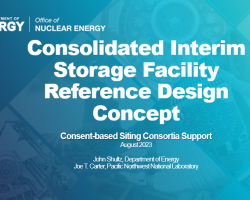Category of Content
Siting Experience Documents Only
Publication Date
Subject Matter
M4SF-21SN010208034- Surface Sampling Techniques for the Canister Deposition Field Demonstration
M4SF-21SN010208034- Surface Sampling Techniques for the Canister Deposition Field Demonstration
HIGH BURNUP SPENT FUEL DATA PROJECT SISTER ROD TEST PLAN OVERVIEW
HIGH BURNUP SPENT FUEL DATA PROJECT SISTER ROD TEST PLAN OVERVIEW
FEASIBILITY OF USING THE IRRADIATED FUEL STORAGE FACILITY (IFSF) TO REMOVE COMMERCIAL USED FUEL FROM THE REA-2023 CASK
FEASIBILITY OF USING THE IRRADIATED FUEL STORAGE FACILITY (IFSF) TO REMOVE COMMERCIAL USED FUEL FROM THE REA-2023 CASK
Water Detection in Used Fuel Canisters M4 2016 Annual Report?
Water Detection in Used Fuel Canisters M4 2016 Annual Report?
Summary of SRNL Activities in Support of the FY2011 UFD R&D Opportunities Task
Summary of SRNL Activities in Support of the FY2011 UFD R&D Opportunities Task
Used Fuel Research and Development Test and Validation Facility Cost Study
Used Fuel Research and Development Test and Validation Facility Cost Study
Sensor Development for Liquid Water Detection in Dry Storage Casks FY2021 Status
Sensor Development for Liquid Water Detection in Dry Storage Casks FY2021 Status
Inspection of Used Fuel Dry Storage Casks
Inspection of Used Fuel Dry Storage Casks
Post Irradiation Examination Plan for High Burnup Demonstration Project Sister Rods
Post Irradiation Examination Plan for High Burnup Demonstration Project Sister Rods
Sister Rod Nondestructive Examination Annual Report FY2017?
Sister Rod Nondestructive Examination Annual Report FY2017?
Feasbility of Using the Irradiated Fuel Storage Facility (IFSF) to Remove Commercial Used Fuel from the REA-2023 Cask
Feasbility of Using the Irradiated Fuel Storage Facility (IFSF) to Remove Commercial Used Fuel from the REA-2023 Cask
Sensor Development for Liquid Water Detection in Dry Storage Casks: FY19 Status
Sensor Development for Liquid Water Detection in Dry Storage Casks: FY19 Status
Guidance for Creating a Community Benefits Plan for Regional Direct Air Capture Hubs
Guidance for Creating a Community Benefits Plan for Regional Direct Air Capture Hubs
This document is intended to provide supplemental information to assist applicants developing a Community Benefits Plan (CBP) for the Regional Direct Air Capture Hubs. As shown in the graphic to the right, Community Benefits Plans are based on a set of four core interdependent policy priorities: engaging communities and labor; investing in America's workforce; advancing diversity, equity, inclusion, and accessibility; and implementing Justice40.
Policies for Achieving Energy Justice in Society: Best Practices for Applying Solar Energy Technologies to Low-Income Housing
Policies for Achieving Energy Justice in Society: Best Practices for Applying Solar Energy Technologies to Low-Income Housing
Studies indicate that the energy burden — energy costs as a percentage of annual family income — on low-income families is inordinately high, compared to that of the rest of the population. Rising fuel costs exacerbate this problem. Residential solar energy systems can help address this situation by furnishing a price-stable energy source with the added benefit of reduced greenhouse gas emissions. However, without appropriate incentives, these systems are prohibitively expensive for low-income families.
Topical Analysis of Nuclear Experts' Perceptions of Publics, Nuclear Energy, and Sustainable Futures
Topical Analysis of Nuclear Experts' Perceptions of Publics, Nuclear Energy, and Sustainable Futures
Nuclear energy experts consider commercial power from fission to be a strong contender to help mitigate the increasing effects of climate change, in part due to its low-to-no carbon emissions. Nevertheless, nuclear energy's history, including meltdowns such as Three Mile Island, Chernobyl, and Fukushima, and dumping in sacred Indigenous land such as Yucca Mountain, raises important concerns in public deliberation over nuclear power.
Nuclear power and the public: an update of collected research on nuclear power
Nuclear power and the public: an update of collected research on nuclear power
The purpose of this research was to collect, analyze, and summarize all of the nuclear power-related surveys conducted in the United States through June, 1981, that we could obtain. The surveys collected were national, statewide, and areawide in scope. Slightly over 100 surveys were collected for an earlier, similar effort carried out in 1977. About 130 new surveys were added to the earlier survey data. Thus, about 230 surveys were screened for inclusion in this report.
Survey of National Programs for Managing High-Level Radioactive Waste and Spent Nuclear Fuel: 2022 Update
Survey of National Programs for Managing High-Level Radioactive Waste and Spent Nuclear Fuel: 2022 Update
In October 2009, the U.S. Nuclear Waste Technical Review Board (Board or NWTRB) published Survey of National Programs for Managing High-Level Radioactive Waste and Spent Nuclear Fuel. For each of the 13 national programs studied, the report catalogued 15 institutional arrangements that had been set in place and 15 technical approaches that had been taken to design repository systems for the long-term management of high-activity radioactive waste.
Consolidated Interim Storage Facility Reference Design Concept
Consolidated Interim Storage Facility Reference Design Concept
Presentation slides on the Consolidated Interim Storage Facility Reference Design Concept, including site plans; handling, inspection and repackaging concepts and facilities; and cost and staffing estimates.


